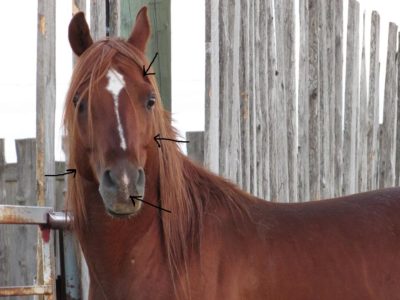Aurene CF and the survival of old desert Arabian type
The photos Hannah Logan posted on her Facebook page made my day this morning. Hannah is a new breeder who acquired several horses from Marilyn McHallam’s herd in British Columbia, and they seem to be thriving.
I was particularly pleased to see this nice photo of the 2004 Kuhaylan Haifi Davenport stallion Aurene CF (Triermain CF x Aureole CF by Fair Sir) after all these years; I had seen him at Craver Farms as a two year old in 2006 — I had mentioned the possibility of exporting a Davenport stallion to Syria, and Charles Craver suggested Aurene. Charles thought highly of him. I saw Aurene again at Pamela Klein’s in Southern Virginia in 2010 (I think) and liked him even better. In 2012, Pamela drove Aurene up to Pennsylvania for breeding to one of my older mares, Bint al-Barra. She took, but then absorbed the pregnancy.
Five things amateurs of the old type of Arabian horses would like in this photo of Aurene: first, the long forelocks, a sign of asalah — authenticity, and a favorite feature of the Prophet Muhammad; second, the prominent facial bones between the eyes and the muzzle that make the face look so dry, another sign of asalah; third, the deep jaw bones, visible on the left of the photo; fourth, the protruding eye sockets common to all desert mammals, and visible to the right of the photo; and fifth, the camel-like muzzle, with the nostrils placed higher, making room for a substantial upper lip, and flat nostrils at rest, which make for the triangular tipped muzzle “a la Sherifa” (see below the drawing of Sherifa’s head by Lady Anne Blunt). Nostrils open only when a horse is excited or in action.
Today’s show champion horses — see for example the specimen below — are being bred for inflated nostrils placed very close to the tip of the muzzle, with the result that the upper lip all but disappears under the nostril, and the tip of the muzzle becomes shaped like a square; they are also being bred for bulging, over-sized eyes, while the protuberance of the eye is only a consequence of the bone structure of the socket — veteran Alepine expert Abu Husayn Khattab used to say that one should be able to easily place a chicken egg above the eye socket; in today’s show horses the dense facial bone structure is gone and the area between the eye and the muzzle has become flat, with only some veins showing; finally, the deep jaw bone is also gone, and the consequence is that heads now have the shape of long rectangles instead of the triangular heads that were traditionally favored by the Arabs.

The photo of Aurene also reminds me of of al-Aawar, who was the last herdsire of the Shammar Bedouins in Northeastern Syria, and the embodiment of that vanishing old type. I wish you were closer than Alberta, Canada, Aurene, my Thalia would find a suitable mate in you.

I am quite pleased to have a grandson of Aurene CF, Prestidigitation (“Your horse with the long name,” – Edouard) 2014 stallion, out of Aurene’s daughter Taylor Made TW, by Presto CF. My hope is that “Pres” will carry on the old desert Arabian type for another generation.
I am so glad to see him doing well in his new home. It looks like Marilyn chose well!
Agreed about the heads being changed and the “old head” being prefered. All parts is summation that created the beautiful head and not the dish. i always thought the appearance of the dish was from the flared nostrils when in movement. Not just in standing.